The World System of Power; "Wardenclyffe"
Shoreham, Long Island, New York
Shoreham, Long Island, New York
THE year 1900 marked to Tesla not only the opening of a new century but also the beginning of the world-superpower and radio-broadcasting era. With the encouragement of J. P. Morgan to spur him on, if he could accommodate any more spurring than his own inner drive furnished, and with $150,000 in cash from the same source, he was set to embark upon a gigantic venture, the building of Wardenclyffe Station, a world wireless-power and a world broadcasting station.
The cash on hand would be totally inadequate to finance the project to completion, but this did not deter him from making a start. He needed a laboratory both to replace the Houston Street establishment, which had become entirely inadequate, and to include equipment of the type employed at Colorado Springs, but designed for use in the actual world-broadcasting process. The location was determined as the result of an arrangement he made with James S. Warden, manager and director of the Suffolk County Land Company, a lawyer and banker from the West who had acquired two thousand acres of land at Shoreham, in Suffolk County, Long Island, about sixty miles from New York. The land was made the basis of a real-estate development under the name Wardenclyffe.
Tesla visualized a power-and-broadcasting station which would employ thousands of persons. He undertook the establishment, eventually, of a Radio City, something far more ambitious than the enterprise in Rockefeller Center in New York which bears this name today. Tesla planned to have all wavelength channels broadcast from a single station, a project which would have given him a complete monopoly of the radio-broadcasting business.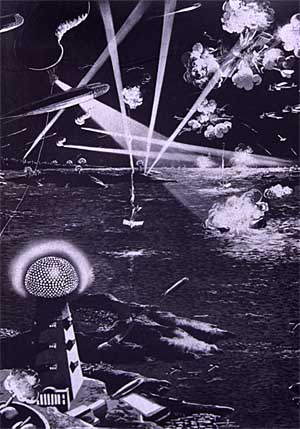 What an opportunity nearsighted businessmen of his day overlooked in not getting in on his project! But in that day Tesla was about the only one who visualized modern broadcasting.
What an opportunity nearsighted businessmen of his day overlooked in not getting in on his project! But in that day Tesla was about the only one who visualized modern broadcasting.
Everyone else visualized wireless as being useful only for sending telegraphic communications between ship and shore and across the ocean. Mr. Warden saw possibilities of a sort in Tesla's plan, however, and offered him a tract of two hundred acres, of which twenty acres were cleared, for his power station, with the expectation that the two thousand men who would shortly be employed in the station would build homes on convenient sites in the remainder of the 2,000-acre tract. Tesla accepted.
Stanford White, the famous designer of many churches and other architectural monuments throughout the country, was one of Tesla's friends. He now disclosed to the famous architect his vision of an industrial "city beautiful'' and sought his cooperation in realizing his dream. Mr. White was enthusiastic about the idea and, as his contribution to Tesla's work, offered to underwrite the cost of designing the strange tower the inventor sketched, and all of the architectural work involved in the general plan for the city. The actual work was done by W. D. Crow, of East Orange, N. J., one of Mr. White's associates, who later became famous as a designer of hospitals and other institutional buildings.
It was a fantastic-looking tower, with strange structural limitations, which Mr. Crow found himself designing. Tesla required a tower, about 154 feet high, to support at its peak a giant copper electrode 100 feet in diameter and shaped like a gargantuan doughnut with a tubular diameter of twenty feet. (This was later changed to a hemispherical electrode.)
The tower would have to be a skeletonized structure, built almost entirely of wood, metal to be reduced to an utter minimum and any metal fixtures employed to be of copper. No engineering data were available on wood structures of this height and type. The structure Tesla required had a large amount of "sail area,'' or surface exposed to wind, concentrated at the top, creating stresses that had to be provided for in a tower that itself possessed only limited stability. Mr. Crow solved the engineering problems and then the equally difficult task of incorporating esthetic qualities in such an edifice.
When the design was completed another difficulty was encountered. None of the well-known builders could be induced to undertake the task of erecting the tower. A competent framer, associated with Norcross Bros., who were a large contracting firm in those days, finally took over the contract, although he, too, expressed fears that the winter gales might overturn the structure. (It stood, however, for a dozen years. When the Government, for military reasons decided it was necessary to remove this conspicuous landmark during the First World War, heavy charges of dynamite were necessary in order to topple it, and even then it remained intact on the ground like a fallen Martian invader out of Wells' "War of the Worlds.")
The tower was completed in 1902, and with it a large low brick building more than 100 feet square which would provide quarters for the powerhouse and laboratory. While the structures were being built, Tesla commuted every day from the Waldorf-Astoria to Wardenclyffe, arriving at the nearby Shoreham 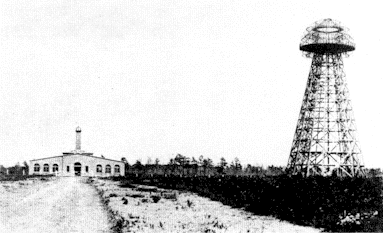 station shortly after eleven am and remaining until three-thirty. He was always accompanied by a man servant, a Serbian, who carried a heavy hamper filled with food. When the laboratory transferred from Houston Street was in full operation at Wardenclyffe, Tesla rented the Bailey cottage near the Long Island Sound shore and there made his home for a year.
station shortly after eleven am and remaining until three-thirty. He was always accompanied by a man servant, a Serbian, who carried a heavy hamper filled with food. When the laboratory transferred from Houston Street was in full operation at Wardenclyffe, Tesla rented the Bailey cottage near the Long Island Sound shore and there made his home for a year.
The heavy equipment, the dynamos and motors, that Tesla desired for his plant were of an unusual design not produced by manufacturers, and he encountered many vexatious delays in securing such material. He was able to carry on a wide range of high-frequency current and other experiments in his new laboratory, but the principal project, that of setting up the worldwide broadcasting station, lagged. Meanwhile, he had a number of glass blowers making tubes for use in transmitting and receiving his broadcast programs. This was a dozen years before De Forest invented the form of radio tube now in general use. The secret of Tesla's tubes died with him.
Tesla seemed to be entirely fearless of his high-frequency currents of millions of volts. He had, nevertheless, the greatest respect for the electric current in all forms, and was extremely careful in working on his apparatus. When working on circuits that might come "alive,'' he always worked with one hand in his pocket, using the other to manipulate tools. He insisted that all of his workers do likewise when working on the 60-cycle low-frequency alternating-current circuits, whether the potential was 50,000 or 110 volts. This safeguard reduced the possibility of a dangerous current finding a circuit through the arms across the body, where there was chance that it might stop the action of the heart.
In spite of the great care which he manifested in all of his experimental work, he had a narrow escape from losing his life at the Wardenclyffe plant. He was making experiments  on the properties of small-diameter jets of water moving at high velocity and under very high pressures, of the order of 10,000 pounds per square inch. Such a stream could be struck by a heavy iron bar without the stream being disrupted. The impinging bar would bounce back as if it had struck another solid iron bar...a strange property for a mechanically weak substance like water. The cylinder holding the water under high pressure was a heavy one made of wrought iron. (See Viktor Schauberger on this site, to find out why water behaves this way!)
on the properties of small-diameter jets of water moving at high velocity and under very high pressures, of the order of 10,000 pounds per square inch. Such a stream could be struck by a heavy iron bar without the stream being disrupted. The impinging bar would bounce back as if it had struck another solid iron bar...a strange property for a mechanically weak substance like water. The cylinder holding the water under high pressure was a heavy one made of wrought iron. (See Viktor Schauberger on this site, to find out why water behaves this way!)
Tesla was unable to secure a wrought-iron cap for the upper surface, so he used a heavier one of cast iron, a more brittle metal. One day when he raised the pressure to a point higher than he had previously used, the cylinder exploded. The cast-iron cap broke and a large fragment shot within a few inches of his face as it went on a slanting path upward and finally crashed through the roof. The high-pressure stream of water had peculiar destructive effects on anything with which it came in contact, even tough, strong metals. Tesla never revealed the purpose or the results of these high-pressure experiments.
Tesla's insistence on the utmost neatness in his laboratory (interior view - right)  almost resulted in a tragedy through a case of thoughtlessness on the part of an assistant. Arrangements were being made for installing a heavy piece of machinery which was to be lag bolted to the thick concrete floor. Holes had been drilled in the concrete. The plan called for pouring molten lead into these holes and screwing the heavy bolts into the metal when it cooled. As soon as the holes were drilled, a young assistant starting cleaning up the debris. He not only swept up the stone chips and dust: he got a mop and thoroughly washed that area of the floor, thoughtlessly letting some of the water get into the holes. He then dried the floor. In the meantime Tesla and George Scherff, who was his financial secretary but also served in any way in which he could be helpful, were melting the lead which would hold the lag screws in the holes in the floor. Scherff took the first large ladleful of lead from the furnace and started across the laboratory to where the holes had been drilled, followed shortly by Tesla bearing another ladle.
almost resulted in a tragedy through a case of thoughtlessness on the part of an assistant. Arrangements were being made for installing a heavy piece of machinery which was to be lag bolted to the thick concrete floor. Holes had been drilled in the concrete. The plan called for pouring molten lead into these holes and screwing the heavy bolts into the metal when it cooled. As soon as the holes were drilled, a young assistant starting cleaning up the debris. He not only swept up the stone chips and dust: he got a mop and thoroughly washed that area of the floor, thoughtlessly letting some of the water get into the holes. He then dried the floor. In the meantime Tesla and George Scherff, who was his financial secretary but also served in any way in which he could be helpful, were melting the lead which would hold the lag screws in the holes in the floor. Scherff took the first large ladleful of lead from the furnace and started across the laboratory to where the holes had been drilled, followed shortly by Tesla bearing another ladle.
Scherff bent down, and as he poured the hot liquid metal into one of the holes an explosion followed instantly. The molten lead was blown upward into his face in a shower of searing hot drops of liquid metal. The water which the assistant used to swab the floor had settled into the holes and, when the melted lead come in contact with it, it was changed to steam which shot the lead out of the hole like a bullet out of the barrel of a riffle. Both men were showered with drops of hot metal and dropped their ladles. Tesla, being several feet away, was only slightly injured; but Scherff was very seriously burned about the face and hands. Drops of the metal had struck his eyes and so severely burned them that it was feared for a while that his sight could not be saved. However, despite the almost unlimited possibilities for accidents in connection with the vast variety of experiments which Tesla conducted in totally unexplored fields, using high voltages, high amperages, high pressures, high velocities and high temperatures, he went through his entire career with only one accident in which he suffered injury.
In that a sharp instrument slipped, entered his palm and penetrated through the hand. The accident to Scherff was the only one in which a member of his staff was injured, with the exception of a young assistant who developed X-ray burns. He had probably been exposed to the rays from one of Tesla's tubes which, unknown to Tesla and everyone else, had been producing them even before Roentgen announced their discovery. Tesla had given them another name and had not fully investigated their properties. This was probably the first case of X-ray burns on record.
Tesla was an indefatigable worker, and it was hard for him to understand why others were incapable of such feats of endurance as he was able to accomplish. He was willing to pay unusually high wages to workers who were willing to stick with him on protracted tasks but never demanded that anyone work beyond a reasonable day's labor. On one occasion a piece of long-awaited equipment arrived and Tesla was anxious to get it installed and operating as quickly as possible. The electricians worked through twenty-four hours, stopping only for meals, and then for another twenty-four hours. The workers then dropped out, one by one, picking out nooks in the building in which to sleep. While they took from eight to twelve hours' sleep, Tesla continued to work; and when they came back to the job Tesla was still going strong and worked with them through his third sleepless twenty-four-hour period. The men were then given several days off in which to rest up; but Tesla, apparently none the worse for his seventy-two hours of toil, went through his next day of experiments, accomplishing a total of eighty-four hours without sleep or rest.
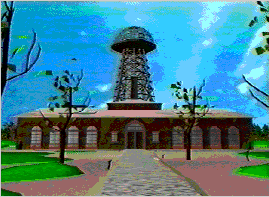 The plant at Wardenclyffe was intended primarily for demonstrating the radio-broadcasting phase of his "World System''; the power-distribution station was to be built at Niagara Falls. Tesla at this time published a brochure on his "World System'' which indicates the remarkable state of advancement he had projected in the wireless art, now called radio, while other experimenters were struggling to acquire familiarity with rudimentary devices. At that time, however, his promises seemed fantastic. The brochure contained the following description of his system and his objectives:
The plant at Wardenclyffe was intended primarily for demonstrating the radio-broadcasting phase of his "World System''; the power-distribution station was to be built at Niagara Falls. Tesla at this time published a brochure on his "World System'' which indicates the remarkable state of advancement he had projected in the wireless art, now called radio, while other experimenters were struggling to acquire familiarity with rudimentary devices. At that time, however, his promises seemed fantastic. The brochure contained the following description of his system and his objectives:
"The World System has resulted from a combination of several original discoveries made by the inventor in the course of long continued research and experimentation. It makes possible not only the instantaneous and precise wireless transmission of any kind of signals, messages or characters, to all parts of the world, but also the interconnection of the existing telegraph, telephone, and other signal stations without any change in their present equipment. By its means, for instance, a telephone subscriber here many call up any other subscriber on the Globe. An inexpensive receiver, not bigger than a watch, will enable him to listen anywhere, on land or sea, to a speech delivered, or music played in some other place, however distant."
"These examples are cited merely to give an idea of the possibilities of this great scientific advance, which annihilates distance and makes that perfect conductor, the Earth, available for all the innumerable purposes which human ingenuity has found for a line wire. One far reaching result of this is that any device capable of being operated through one or more wires (at a distance obviously restricted) can likewise be actuated, without artificial conductors and with the same facility and accuracy, at distances to which there are no limits other than those imposed by the physical dimensions of the Globe. Thus, not only will entirely new fields for commercial exploitation be opened up by this ideal method of transmission, but the old ones vastly extended."
While at work on his Wardenclyffe radio-broadcasting plant, Tesla was also evolving plans for establishing his world power station at Niagara Falls. So sure was he of the successful outcome of his efforts that he stated in a newspaper interview in 1903 that he would light the lamps of the coming international exposition in Paris with power wirelessly transmitted from the Falls. Circumstances, however, prevented him from making good this promise. His difficulties and his plans were outlined in a statement published in the Electrical World and Engineer, March 5, 1904: (Below)
Compliments: Gary Peterson of 21st Century Books,
http://www.tfcbooks.com ; used by permission.
Edited: Frank Germano
WARDENCLYFFE STATION :
The history and design of
Tesla’s Magnifying Transmitter
“The tower was destroyed two years ago but my projects are being developed and another one, improved in some features, will be constructed. . . . My project was retarded by laws of nature. The world was not prepared for it. It was too far ahead of time, but the same laws will prevail in the end and make it a triumphal success.” —
I. INTRODUCTION
Radio communications, fluorescent lighting and AC power, these are all familiar and vital components of life as we know it in the latter part of the twentieth century and all were contributions of the prolific turn-of-the-century inventor Nikola Tesla. In spite of their exceptional significance, there are additional inventions that this remarkable man left to the world with the capacity to be of an equivalent or perhaps even greater value to society. Much of
Near the North Shore Long Island community of 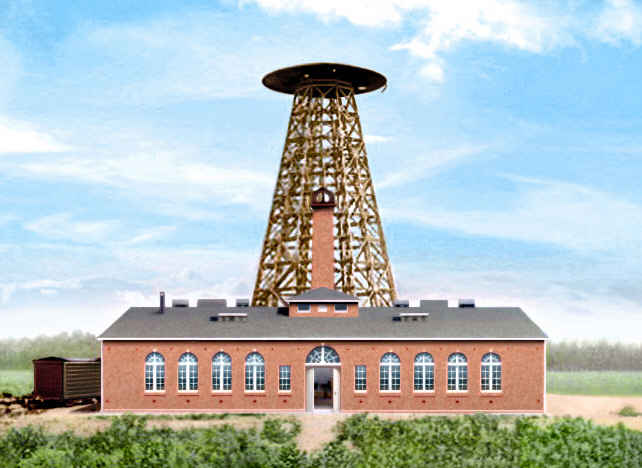 s in the fact that the Wardenclyffe Power Plant /
s in the fact that the Wardenclyffe Power Plant /
The saga of the building’s history, from its construction in 1902 alongside a 187-foot companion tower to house the various components of a prototype world broadcasting and telecommunications facility to later less glamorous uses, is a story yet to be fully told. And, there is history in the making as well. For a movement is underway which, if successful, will result in the establishment of the
Figure 1. The Wardenclyffe facility for worldwide broadcasting and wireless telecommunications.
II. BACKGROUND
Just to the east of
Settlement of the area started in the late 1600s and continued on through the year 1800, after being purchased from the indigenous people known as the Montauks. The occupations of the residents were mainly related to farming, a character that the area retains to this day. A cordwood industry eventually developed as well, with logs of chestnut, oak and pine being shipped by sailing vessel to heat homes and fuel brickyard kilns in nearby
III. WARDENCLYFFE-ON-SOUND
About 50 years later, having just returned to
Seeing an opportunity in land development, a western lawyer and banker by the name of
The Wardenclyffe World Wireless facility as envisioned by Tesla was to have been quite different from radio broadcasting stations, as they presently exist. While there was to be a great similarity in the apparatus employed, the method in which it was to be utilized would have been radically different. Conventional transmitters are designed so as to maximize the amount of electromagnetic radiation emitted by the antenna structure. For long-range communications such equipment must process tremendous amounts of power in order to counteract the loss in field strength (P = 1/R2) encountered as the signal radiates outward from its point of origin.
The transmitter at Wardenclyffe was configured so as to minimize the radiated power. The energy of Tesla’s steam driven Westinghouse 200 kW alternator was to be channeled instead into an underground structure consisting of iron pipes driven from a point 120 feet beneath the tower’s base. [2] This was to be accomplished by combining an extremely low frequency signal (ELF) along with the higher frequency current coursing between the earth and the transmitter’s elevated terminal [through the master oscillator and helical resonator]. The low frequency current in the presence of an enveloping corona-induced plasma of free charge carriers would have “pumped” the earth’s charge. [3] It is believed the resulting ground current and its associated wave complex would have allowed the propagation of wireless transmissions to any distance on the earth’s surface with as little as 5% loss due to electromagnetic radiation.
The terrestrial transmission line modes so excited would have supported a system with the following technical capabilities:
1. Establishment of a multi-channel global broadcasting system with programming including news, music, et cetera;
2. Interconnection of the world’s telephone and telegraph exchanges, and stock tickers;
3. Transmission of written and printed matter, and data;
4. World wide reproduction of photographic images;
5. Establishment of a universal marine navigation and location system, including a means for the synchronization of precision timepieces;
6. Establishment of secure wireless communications services. [4] Additional World System capabilities and related technologies include,
7. Remote control and propulsion of UAV “atmospheric satellites” in long duration flight.
8. Wireless transmission of electrical energy for propulsion of aerial and other vehicles, and industrial purposes.
9. Geophysical exploration [Waite ]
10. Weather control, artificial rain; climate control
11. Macroscopic charged particle beam projection
12. Electrical projection of explosive energy
13. Electrotherapeutics
14. Electronic logic gate and digital computing allow, a) Software defined radio b) Digital world-system broadcasting and terrestrial network backbone c) Artificial intelligence
15. Interplanetary Communications providing a stable, high-capacity interplanetary network backbone supporting high-speed Internet protocols.
IV. THE WARDENCLYFFE POWER PLANT AND LABORATORY—History and Design
The design of Tesla’s World-System installation can be traced back to 1892 and his preliminary investigations at the 35 South Fifth Avenue lab. In Tesla‘s words, “The first gratifying result was obtained in the spring of the succeeding year, when I reached a tension of about 1,000,000 volts with my conical coil.” Further development took place in his Houston Street lab where he achieved potentials of 4,000,000 volts with a larger flat-spiral coil.He made observations related to selective tuning, developing techniques for spreading the transmitted RF energy in both the frequency and time domains—spread spectrum.
I n 1899
Upon the conclusion of his preliminary investigations
"I have just returned from
Colorado , where I have been carrying on some experiments since a few months past. The success has been even greater than I anticipated, and among other things I have absolutely demonstrated the practicability of the establishment of telegraphic communication to any point on the globe by the help of the machinery I have perfected."
Tesla’s short-term goal was to build a prototype world-system communications facility. This was intended as the first of many wireless plants that would be located near major p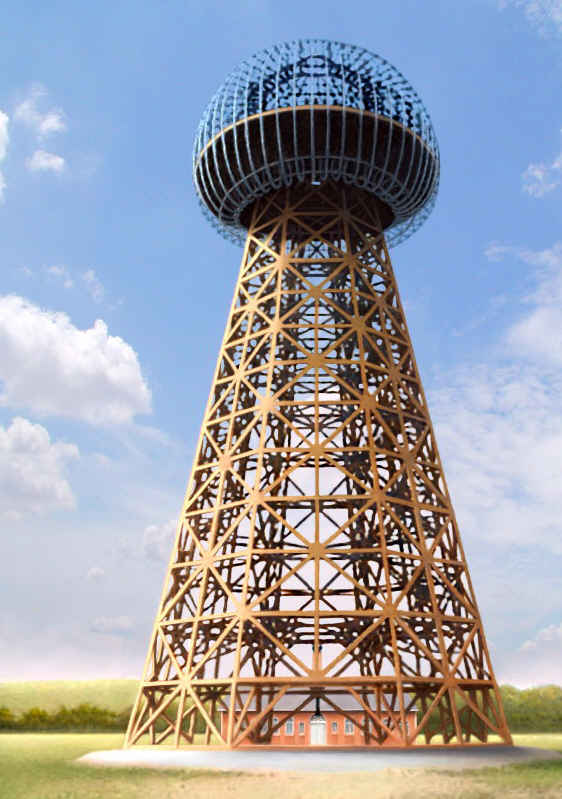 opulation centers around the world. If the program had moved forward without interruption, the Long Island prototype would have been followed by additional stations, the first being built somewhere along the southern coast of England. [5]
opulation centers around the world. If the program had moved forward without interruption, the Long Island prototype would have been followed by additional stations, the first being built somewhere along the southern coast of England. [5]
By the Summer of 1902
The building was essentially completed and octagonal wooden tower had taken form. A 200 kW
Designed by Tesla and
In 1903 the 187-foot tower framework was topped off with a 68-foot diameter, 55-ton terminal capacitance. A graphic rendering by artist Rex Hubbart, shows final appearance of the massive structure had it been completed
Figure 2 (non standard view of the Magnifying Transmitter - compliments, Rex Hubbart)
In order to provide the requisite ground connection Tesla excavated a 120 foot deep, 10 x 12 foot wood and steel-lined shaft directly below the tower.
Using special machines at the bottom of the shaft, individual sections of steel pipe were pushed piece by piece into the
In July 1903
. . . The old plant has never worked beyond a few hundred miles. Apart of imperfections of the apparatus design there were four defects, each of which was fatal to success. It does not seem probable that the new plant will do much better, for these faults were of a widely different nature and difficult to discover. As to the remedies, I have protected myself in applications filed 1900 - 1902, still in the office.
The “old plant” refers to the Colorado Springs Experimental Station or perhaps an initial Wardenclyffe installation bearing a  resemblance to it. A fair estimate of the ‘imperfections’ can be made through a comparison with the final Wardenclyffe Plant design. For starters, the
resemblance to it. A fair estimate of the ‘imperfections’ can be made through a comparison with the final Wardenclyffe Plant design. For starters, the
The Wardenclyffe extra coil illustrated in U.S. Patent, No. 1,1191,732, “Apparatus for Transmitting Electrical Energy,”
Second, the elevated capacitance in
In contrast, the Wardenclyffe elevated capacitance consisted of a large oblate spheroid mounted on top of an insulating wooden structure.
In the 1914 patent the connection from the top of the extra coil to the elevated terminal is shown as a relatively short, large diameter metal cylinder. [Footnote 2.]
Figure 3.
Below Right -
A scale comparison of the Colorado Springs Experimental Station and a Wardenclyffe-type installation (Figure two above to Fig three, below right).
In spite of these and some additional shortcomings, the 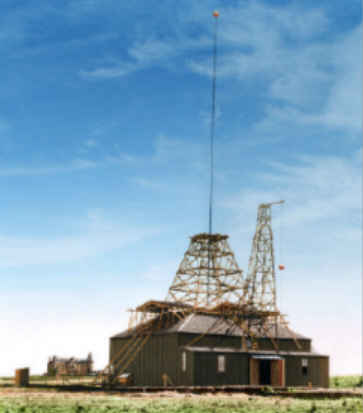 arrangement illustrated in figures 5 and 6 was the most promising.
arrangement illustrated in figures 5 and 6 was the most promising.
It shows up with slight variations at a number of places in the Colorado Springs Notes, most significantly on pages 191, 200, 197 and 170 (see also pages 161, 162, 174, 177 and 184). In the corresponding text on page 191 Tesla writes, “In Fig. 5. & 6. it is found best to make [the] extra coil ¾ wave length and the secondary ¼ for obvious reasons.”
In the
The initial conceptual plan for Wardenclyffe, as illustrated in figure 4, was tied in with an idea
Alterations of the initial Wardenclyffe design led to the arrangement shown in a sketch dated
The circuit incorporates a dual capacitor-inductor [LC] arrangement in the oscillatory transformer primary tank circuit along with dual secondary windings. Independent tuning the two sides of the circuit to different frequencies (n/4 lambda, n being an uneven number) would result in the development of a higher order wave complex above the resonant frequency of the extra coil. [“The transmitter was to emit a wave-complex of special characteristics. . . .” My Inventions].
In [figure 6] the straight conducting legs have been modified to a spiral form. An obvious advantage would be a reduction in the structure’s overall height above ground level. Also notice that the number of turns varies from leg to leg. This would also result in the development of a higher order wave complex by the transmitter—a form of frequency-division multiplexing.
Regarding the “four defects” of the Colorado Springs plant, one of them could have been the plan that involved coupling by corona discharge between the extra coil and the conducting hood that Tesla had installed at the lower end of the insulated metal tower (see CSN pp. 197, 334, Phot. X for example.
As for the “remedies” protected in applications filed between 1900 and 1902, and “still in the office,” the only patented invention meeting these criteria is “Apparatus for Transmitting Electrical Energy,” No. 1,119,732, issued
An unanswered question is the purpose of what appears to be a flat-spiral coil suspended within the large elevated terminal [the cupola]. In Colorado Springs Tesla specified a coil to be used in conjunction with a resonator when no ball termination was present. The additional inductance served to lower the resonant frequency of the vibrating system back to the resonant frequency with the ball present. It is conceivable this technique was adapted to achieve an overall lower frequency by using both the additional coil and the terminal capacitance. [See CSN, p. 203 for illustration of the additional coil, form #5, “coil used in series with extra coil when ball was not employed.”]
FOOTNOTES:
[1] In 1916
In this system that I have invented it is necessary for the machine to get a grip of the earth, otherwise it cannot shake the earth. It has to have a grip on the earth so that the whole of this globe can quiver, and to do that it is necessary to carry out a very expensive construction. I had in fact invented special machines. . . . There was a big shaft about ten by twelve feet goes down about one hundred and twenty feet and this was first covered with timber and the inside with steel and in the center of this there was a winding stairs going down and in the center of the stairs there was a big shaft again through which the current was to pass . . . And then the real expensive work was to connect that central part with the earth, and there I had special machines rigged up which would push the iron pipe, one length after another, and I pushed these iron pipes, I think sixteen of them, three hundred feet, and then the current through these pipes takes hold of the earth. Now that was a very expensive part of the work, but it does not show on the tower, but it belongs to the tower. [Ref. #2, p. 203]
[2] Two other seemingly applicable patents filed for within the specified time period and patented in 1900 are “Means for Increasing the Intensity of Electrical Oscillations,” No. 787,412 and “Method of Insulating Electrical Conductors,” No. 655,838, reissued as No. 11,865. Both of these inventions might have been useful for improving the Wardenclyffe plant’s performance; the first for the magnifying transmitter itself, the second for improving high-voltage power transmission between the lab building and the tower structure.
REFERENCES:
[1] History of Shoreham,
[2] Nikola Tesla On His Work With Alternating Currents and Their Application to Wireless Telegraphy, Telephony and Transmission of Power, L.I. Anderson, Sun Publishing, Denver 1992.
[3] “Spherical Transmission Lines and Global Propagation,” K.L. Corum and J.F. Corum, Proceedings of the 1996 International Tesla Symposium,
[4] “My Inventions,”
[5]
[6] “Wardenclyffe, Forfeited Dream,”
[7] Nikola Tesla On His Work With Alternating Currents and Their Application to Wuireless Telegraphy, Telephony and Transmission of Power, Leland I. Anderson, editor, Twenty First Century Books, 2002.
[8]
[ 9 ] Prodigal Genius — The Life of Nikola Tesla, John J. O’Neill, Ives Washburn, Inc., 1944.
[10]
[ 11 ]
[12] Tesla — Man Out Of Time,
[13] “
[14] “Radio Pioneer at Shoreham,”
[15] “RI/FS Work Plan,” Groundwater Technology,
[16] “In Recognition,” Brookhaven Bulletin,
Miscellaneous notes:
Tesla’s method of wireless transmission was covered by the following U.S. Patents:
No. 613,809, “Method and Apparatus for Controlling Mechanism of Moving Vessel or Vehicles,”
No. 645,576, “System of Transmission of Electrical Energy,”
Nos. 685,953, 685,954, 685,955, and 685,956,
The AND logic-gate patents,
No. 723,188, “Method of Signaling,”
No. 725,605, “System of Signaling,”
No. 787,412, “
No. 1,1191,732, “Apparatus for Transmitting Electrical Energy,”
Some of Tesla’s inventions have long been accepted as part of daily life, for example AC power, broadcasting and, more recently, high frequency lighting. And, Tesla turbo-machinery are just now beginning to see some use, especially in the industrial arena. This is not so much the case with Tesla’s more advanced concepts. The proposed “World System” is a prime example. Here is a major invention in which
It has been said the prototype plant was intended as the first installation in a global power distribution system. Actually, it was intended to serve as the western component of a trans-Atlantic wireless telecommunications link.
It is possible that such an arrangement was experimented with at Wardenclyffe, some time between June 1901 and Nov. 1903, as progress with the tower’s construction allowed. In any case, the letter suggests the 1901 scheme was fatally flawed.
My Inventions, Chapter 5
“. . . A plant was built on
“Morgan, who had invested in a project to capitalize on multichannel wireless message transmissions across the Atlantic, was not the least bit interested in industrial power transmission—which Tesla viewed as the ultimate goal.”
“Local residents were aroused at night by startling lightning-like flashes, but no one knew exactly what the activities were at the plant because the whole operation was shrouded in secrecy.”
“Large multi-strand cables connected the shaft termination to the periphery of the sphere.”
E
Read much more on this subject in the book - "Nikola Tesla; Journey To Mars: Are We Already There?!" below -
NEXT
- Nikola Tesla Page 6